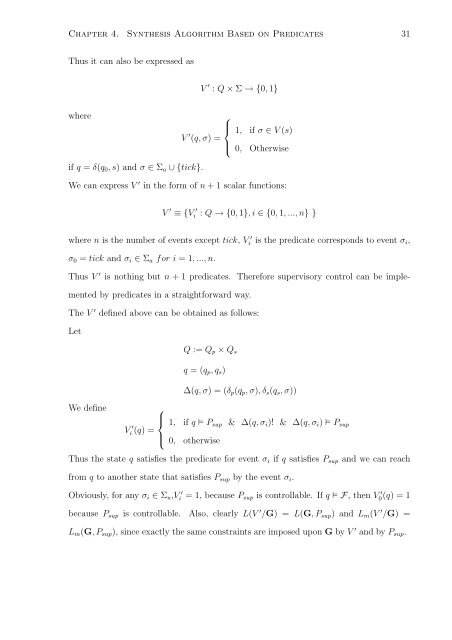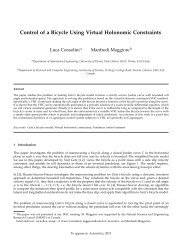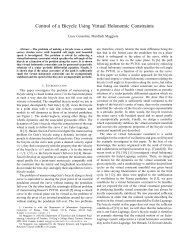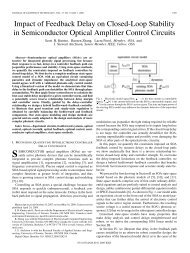State Based Control of Timed Discrete Event Systems using Binary ...
State Based Control of Timed Discrete Event Systems using Binary ...
State Based Control of Timed Discrete Event Systems using Binary ...
You also want an ePaper? Increase the reach of your titles
YUMPU automatically turns print PDFs into web optimized ePapers that Google loves.
Chapter 4. Synthesis Algorithm <strong>Based</strong> on Predicates 31Thus it can also be expressed asV ′ : Q × Σ → {0, 1}where⎧⎪⎨ 1, if σ ∈ V (s)V ′ (q, σ) =⎪⎩ 0, Otherwiseif q = δ(q 0 , s) and σ ∈ Σ a ∪ {tick}.We can express V ′ in the form <strong>of</strong> n + 1 scalar functions:V ′ ≡ {V ′i : Q → {0, 1}, i ∈ {0, 1, ..., n} }where n is the number <strong>of</strong> events except tick, V ′i is the predicate corresponds to event σ i ,σ 0 = tick and σ i ∈ Σ a for i = 1, ..., n.Thus V ′ is nothing but n + 1 predicates. Therefore supervisory control can be implementedby predicates in a straightforward way.The V ′ defined above can be obtained as follows:LetQ := Q p × Q sq = (q p , q s )∆(q, σ) = (δ p (q p , σ), δ s (q s , σ))We define⎧⎪⎨V i ′ (q) =⎪⎩1, if q P sup & ∆(q, σ i )! & ∆(q, σ i ) P sup0, otherwiseThus the state q satisfies the predicate for event σ i if q satisfies P sup and we can reachfrom q to another state that satisfies P sup by the event σ i .Obviously, for any σ i ∈ Σ u ,V ′i = 1, because P sup is controllable. If q F, then V ′0(q) = 1because P sup is controllable. Also, clearly L(V ′ /G) = L(G, P sup ) and L m (V ′ /G) =L m (G, P sup ), since exactly the same constraints are imposed upon G by V ′ and by P sup .







